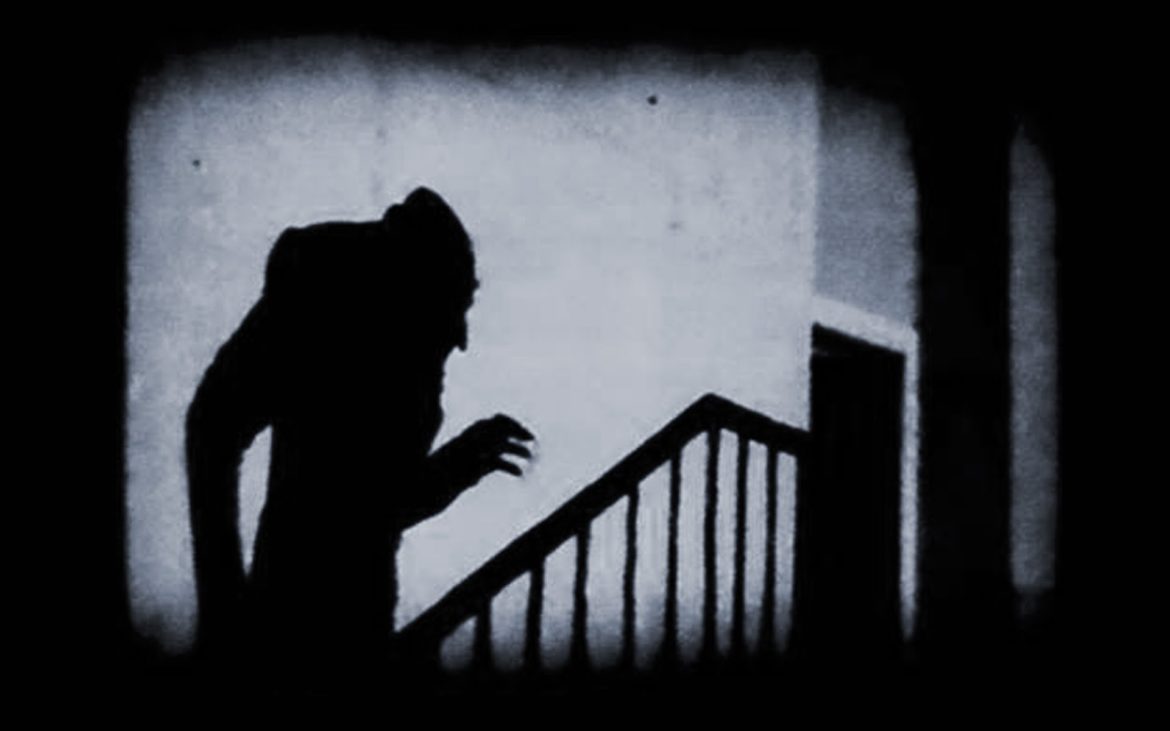Part of an ongoing effort to watch each of the films in Roger Ebert’s Great Movies series. The introduction and full list can be found here.
As our shared monsters and shadowy nightmare figures go, the vampire is particularly stubborn in its refusal to vanish from the scene. “Deathless,” one might say. (Editor’s note: Stop saying that.) F.W. Murnau’s Nosferatu, an adaptation of Bram Stoker’s Dracula so shameless in its pilferings the Stoker estate sued, is arguably the cinematic touchstone for this impulse that will not die.
Why the vampire? Books can, and have, been written about this, and there are probably as many explanations as there are explainers. In the vampire, we have an archetypal Other, the one from Over There. He always comes from the east, from across the mountains – there’s a fair amount of anti-Roma prejudice in its DNA, and anti-Semitism, too, but the text is open. We have blood, decaying castles, lust, plague, eternal youth, boundless memory and thus centuries of injustice and revenge, the more unexplained motivations guiding unknowable evil, the predatory impulses reduced to their essentials. In some tellings, we have sex incarnate; in others, we have a figure of impotence turned violent in lieu of release. In more recent ones, the plague fears that animate its creation are mapped to AIDS, to the venereal, to blood-borne pathogens in general. Every age, it appears, will have its vampiric menace.
A few years ago, it seemed we had hit Peak Vampire. The Twilight saga – with its pining lovers and increasingly ludicrous plotting – had become transparently ridiculous and almost single-handedly elicited a collective groan from movie-goers who hoped for some of the old magic. (The subsequent careers of Kristen Stewart and Robert Pattinson, two of the best actors working today, might make us tone down that harshness, though, in retrospect.) How had we sunk so low?
As usual, the obituaries were printed too early. Jim Jarmusch’s Only Lovers Left Alive was a shot in the arm for the mythology, with its Vampire Rock Stars and blood popsicles; Ana Lily Amirpour’s A Girl Walks Home Alone At Night found new and different subtexts to bring forward. The post-Flight Of The Conchords mockumentary What We Do In The Shadows was the funniest movie of last year, and dove right into the genre with an abashed glee, both lovingly and knowingly. The vampire had returned, as is its wont. If nothing else, the vampire is very good at returning.
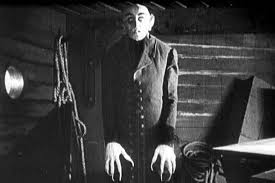 Back in 1922, at the height of German Expressionist Cinema, Murnau’s Nosferatu told a different tale. With an arsenal of arched doorways, coastal graveyards, uncanny moments of telepathy, looming shadows, wafting fog, keyhole dissolves, and the sense that things were deeply wrong in the fabric of our waking dreams, his vampire was neither cool, nor feminist, nor funny. He was meant to be scary, and he was.
Back in 1922, at the height of German Expressionist Cinema, Murnau’s Nosferatu told a different tale. With an arsenal of arched doorways, coastal graveyards, uncanny moments of telepathy, looming shadows, wafting fog, keyhole dissolves, and the sense that things were deeply wrong in the fabric of our waking dreams, his vampire was neither cool, nor feminist, nor funny. He was meant to be scary, and he was.
Is he still? I think so. As played by Max Schreck – all bat ears, shocked and open eyes, bald head, long fingers, and those rat-like teeth – Nosferatu’s about as far removed from Sexy Dracula as one could get. He’s not of this world. His movements are stiff and lumbering, and his power never in doubt. More than anything, he’s a malevolent force, and an old one. We get the sense that Jonathon Harker – called Hutter in Murnau’s German reading, and played clumsily by Gustav von Wangenheim (a much scarier name, incidentally) – has unleashed something unspeakable when he shows up in the Carpathian Mountains to close his famous real estate deal, which will provide him and his love with funds, in exchange for becoming neighbors with Evil itself. Nosferatu has been waiting.
From its earliest moments, the film is full of menace and portent. The high-backed chairs on which Harker’s boss Renfield sits are out of place and odd. Shadows lurk everywhere in Nosferatu. People are so aware of what’s coming they make terrible jokes, like Renfield telling Harker his trip might cost him “a little blood.” Later, a professor showcases the Venus Fly Trap for his students as it devours a fly; Murnau cuts to Renfield, at this point locked away in a madhouse, catching and eating flies himself. Audiences then knew the story, maybe better than we do now, and nothing good is coming.
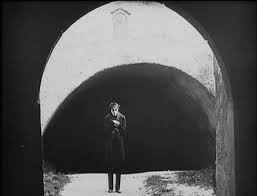 Schreck is the crux of the film’s horror, and it works to this day. His introduction, emerging from the shadows at his impossibly Gothic castle; the quickness with which he sucks blood from Harker’s accidentally cut finger; the way he moves, coming slowly but terrifyingly upright from a coffin, or emerging wide-eyed from below a boat’s hold … a boat, called “The Demeter”, filled with corpses and plague … this is the stuff of horror, for sure. Murnau’s genius is in the pacing, and the ever-shifting darkness, and the tiny, uncanny details, like the frames within frames. Everyone in Nosferatu has nightmares that they shrug off. Everyone in this film can, without explanation, sense almost telepathically the danger others are in across the world. It’s a dreamscape filled with rats, plague, and inexplicable menace, and one which Murnau never feels compelled to explain down to the detail. This helps enormously; there is nothing worse than hearing someone tell you what a dream means.
Schreck is the crux of the film’s horror, and it works to this day. His introduction, emerging from the shadows at his impossibly Gothic castle; the quickness with which he sucks blood from Harker’s accidentally cut finger; the way he moves, coming slowly but terrifyingly upright from a coffin, or emerging wide-eyed from below a boat’s hold … a boat, called “The Demeter”, filled with corpses and plague … this is the stuff of horror, for sure. Murnau’s genius is in the pacing, and the ever-shifting darkness, and the tiny, uncanny details, like the frames within frames. Everyone in Nosferatu has nightmares that they shrug off. Everyone in this film can, without explanation, sense almost telepathically the danger others are in across the world. It’s a dreamscape filled with rats, plague, and inexplicable menace, and one which Murnau never feels compelled to explain down to the detail. This helps enormously; there is nothing worse than hearing someone tell you what a dream means.
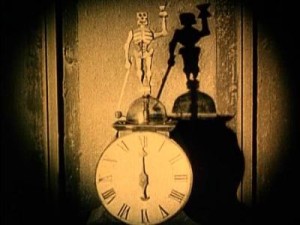 The weak spot here, as in every adaptation I know of, is Harker. For such a central figure, it’s odd how insistently he slips into the background. He should be an audience stand-in, but mostly feels like a plot device. In Murnau’s telling, he’s somewhat of a boor and a big-city goofball, laughing hysterically at the peasants’ fears of the night and almost comically throwing down a book about vampires to the floor out of bewilderment with small-town ways, while setting off for the most dangerous castle in the Carpathian Mountains.
The weak spot here, as in every adaptation I know of, is Harker. For such a central figure, it’s odd how insistently he slips into the background. He should be an audience stand-in, but mostly feels like a plot device. In Murnau’s telling, he’s somewhat of a boor and a big-city goofball, laughing hysterically at the peasants’ fears of the night and almost comically throwing down a book about vampires to the floor out of bewilderment with small-town ways, while setting off for the most dangerous castle in the Carpathian Mountains.
This makes sense as a knock on over-serious Modern Cosmopolitans who disdain the provincial and all the old stories – and that’s certainly a theme horror would return to again and again. But it doesn’t generate much sympathy for the character, who by all rights we should be somewhat aligned with. Watch him laugh and laugh at the villagers on his way to the castle, and then try to feel bad for him; it’s not possible. There is something tricky about Harker, some nuance filmmakers have never really captured in my opinion, and which reached its nadir with Keanu Reeves trying, and failing in spectacular fashion, to appear serious in Coppola’s Bram Stoker’s Dracula. Harker is fundamentally an interior character, a set of thoughts and a pair of eyes through which to observe. But this doesn’t help much on screen.
In any case, though, Nosferatu is not his story. Or not anymore. This tale belongs to the vampire and his coffins full of plague soil, his unquenchable thirst for innocent blood, and the fear we all have, sometimes, that there’s no explanation for this business at all. Where Coppola created a backstory of ancient love, and where Twilight preferred essentially a supernatural high school love triangle, Nosferatu has a different, and more punishing, vision. Schreck and his creeping, shadowy fingers, his single-minded gaze, suggest maybe evil exists across years, and maybe it can’t be dealt with in any way. At all.
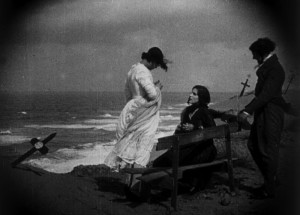 As in most horror, of course, the monster is vanquished at the end. You can’t send the audience out in depressed terror in 1922.
As in most horror, of course, the monster is vanquished at the end. You can’t send the audience out in depressed terror in 1922.
But then you remember an early title card that referred to “the first Nosferatu.” Not the last. Who knows what cargo ships are carrying, right now, to the graveyards near your shores.
Favorite Ebert line: “It is commonplace to say that silent films are more “dreamlike,” but what does that mean? In “Nosferatu,” it means that the characters are confronted with alarming images and denied the freedom to talk them away. There is no repartee in nightmares. Human speech dissipates the shadows and makes a room seem normal. Those things that live only at night do not need to talk, for their victims are asleep, waiting.”
Next up: Nanook of the North

